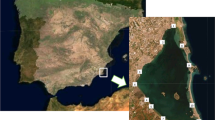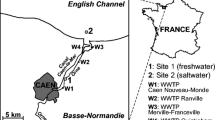Abstract
The applicability of Corbicula as a bioindicator for monitoring organochlorine pesticides (OCPs) in fresh and brackish waters is presented here. Differences in isomer compositions and OCP bioaccumulation levels were analyzed in western Japan and the Pearl River Delta (PRD) in China. Isomer compositions of DDTs, chlordanes, and HCHs were significantly different between the two areas because of their different historical uses and property of the chemicals. This is represented by the (DDE + DDD)/DDT ratio in Corbicula, ranging 4.9–39 in western Japan and 1.1–2.4 in the PRD. However, isomer compositions in Corbicula reflected those in water, and the different patterns in Corbicula likely reflected the usage history. Concentrations of dissolved oxygen, suspended solids, and volatile suspended solids in water, and the difference in species did not influence OCP bioaccumulative levels in Corbicula when conducting biomonitoring. These levels are likely similar to those in Mytilus galloprovincialis. Therefore, Corbicula could be an appropriate bioindicator for monitoring OCPs in fresh and brackish waters.
Similar content being viewed by others
References
Aguillar, A. (1984). Relationship of DDE/DDT in marine mammals to the chronology of DDT input to the ecosystem. Canadian Journal of Fisheries and Aquatic Sciences, 41, 840–844. doi:10.1139/f84-100.
Boonyatumanond, R., Jaksakul, A., Puncharoen, P., & Tabucanon, S. M. (2002). Monitoring of organochlorine pesticides residues in green mussels (Perna viridis) from the coastal area of Thailand. Environmental Pollution, 119, 245–252. doi:10.1016/S0269-7491(01)00329-3.
Bordajandi, L. R., Gomez, G., Fernandez, M. A., Abad, E., Rivera, J., & Gonzalez, M. J. (2003). Study on PCBs, PCDD/Fs, organochlorine pesticides, heavy metals and arsenic content in freshwater fish species from the River Turia (Spain). Chemosphere, 53, 163–171. doi:10.1016/S0045-6535(03)00417-X.
Brown, L. R. (1997). Concentrations of chlorinated organic compounds in biota and bed sediment in streams of the San Joaquin Valley, California. Archives of Environmental Contamination and Toxicology, 33, 357–368. doi:10.1007/s002449900265.
Buchert, H., Class, T., & Ballschmiter, K. (1989). High resolution gas chromatography of technical chlordane with electron capture- and mass selective detection. Fresenius’ Journal of Analytical Chemistry, 333, 211–217. doi:10.1007/BF00490199.
Buser, H. R., & Mueller, M. D. (1995). Isomer and enantioselective degradation of hexachlorocyclohexane isomers in sewage sludge under anaerobic conditions. Environmental Science and Technology, 29, 664–672. doi:10.1021/es00003a013.
Byrne, M., Phelps, H., Church, T., Adair, V., Selvakumaraswamy, P., & Potts, J. (2000). Reproduction and development of the freshwater clam Corbicula australis in southeast Australia. Hydrobiologia, 418, 185–197. doi:10.1023/A:1003986512832.
Chazdon, R. L. (1985). Leaf display, canopy structure, and light interception of two understory palm species. American Journal of Botany, 72, 1493–1502.
Colombo, J. C., Bilos, C., Campanaro, M., Rodriguez Presa, M. J., & Catoggio, J. A. (1995). Bioaccumulation of polychlorinated biphenyls and chlorinated pesticides by the Asiatic clam Corbicula fluminea: Its use as sentinel organism in the Rio de La Plata Estuary, Argentina. Environmental Science and Technology, 29, 914–927. doi:10.1021/10.1021/es00004a011.
Doherty, F. G. (1990). The Asiatic clam, Corbicula spp., as a biological monitor in freshwater environment. Environmental Monitoring and Assessment, 15, 143–181. doi:10.1007/BF00398912.
Feroz, M., & Khan, M. A. Q. (1979). Metabolism, tissue distribution, and elimination of cis-[14C]chlordane in the tropical freshwater fish, Cichlasoma species. Journal of Agricultural and Food Chemistry, 27, 1190–1197. doi:10.1021/jf60226a010.
Fu, J., Mai, B., Sheng, G., Zhang, G., Wang, X., Peng, P., et al. (2003). Persistent organic pollutants in environment of the Pearl River Delta, China: An overview. Chemosphere, 52, 1411–1422. doi:10.1016/S0045-6535(03)00477-6.
Gong, Z. M., Tao, S., Xu, F. L., Dawson, R., Liu, W. X., Cui, Y. H., et al. (2004). Level and distribution of DDT in surface soils from Tianjin, China. Chemosphere, 54, 1247–1253. doi:10.1016/j.chemosphere.2003.10.021.
Gonzalez, M., Miglioranza, K. S. B., Aizpun de Moreno, J. E., & Moreno, V. J. (2003). Organochlorine pesticide residues in Leek (Allium porrum) crops grown on untreated soils from an agricultural environment. Journal of Agricultural and Food Chemistry, 51, 5024–5029. doi:10.1021/jf034349s.
Hakenkamp, C. C., & Palmer, M. A. (1999). Introduced bivalves in freshwater ecosystems: The impact of Corbicula on organic matter dynamics in a sandy stream. Oecologia, 119, 445–451. doi:10.1007/s004420050806.
Jacobs, M. N., Covaci, A., & Schepens, P. (2002). Investigation of selected persistent organic pollutants in farmed Atlantic Salmon (Salmo salar), salmon aquaculture feed, and fish oil components of the feed. Environmental Science and Technology, 36, 2797–2805. doi:10.1021/es011287i.
Jaward, F. M., Zhang, G., Nam, J. J., Sweetman, A. J., Obbard, J. P., Kobara, Y., et al. (2005). Passive air sampling of polychlorinated biphenyls, organochlorine compounds, and polybrominated diphenyl ethers across Asia. Environmental Science and Technology, 39, 8638–8645. doi:10.1021/es051382h.
Jimenez, B. (1997). Environmental effects of endocrine disruptors and current methodologies for assessing wildlife effects. Trends in Analytical Chemistry, 16, 596–606. doi:10.1016/S0165-9936(97)00098-8.
Khaled, A., Nemr, A. E., Said, T. O., El-Sikaily, A., & Abd-Alla, A. M. A. (2004). Polychlorinated biphenyls and chlorinated pesticides in mussels from the Egyptian Red Sea coast. Chemosphere, 54, 1407–1412. doi:10.1016/j.chemosphere.2003.10.042.
Korniushin, A. V. (2004). A revision of some Asian and African freshwater clams assigned to Corbicula fluminalis (Müller, 1774) (Mollusca: Bivalvia: Corbiculidae), with a review of anatomical characters and reproductive features based on museum collections. Hydrobiologia, 529, 251–270. doi:10.1007/s10750-004-9322-x.
Li, J., Zhang, G., Qi, S., Li, X., & Peng, X. (2006). Concentrations, enantiomeric compositions, and sources of HCH, DDT and chlordane in soils from the Pearl River Delta, South China. Science of the Total Environment, 372, 215–224. doi:10.1016/j.scitotenv.2006.09.023.
Loonen, H., Muir, D. C. G., Parsons, J. R., & Govers, H. A. J. (1997). Bioaccumulation of polychlorinated dibenzo-p-dioxins in sediment by oligochaetes: Influence of exposure pathway and contact time. Environmental Toxicology and Chemistry, 16, 1518–1525. doi:10.1002/etc.5620160728.
Luo, X., Mai, B., Yang, Q., Fu, J., Sheng, G., & Wang, Z. (2004). Polycyclic aromatic hydrocarbons (PAHs) and organochlorine pesticides in water columns from the Pearl River and the Macao harbor in the Pearl River Delta in South China. Marine Pollution Bulletin, 48, 1102–1115. doi:10.1016/j.marpolbul.2003.12.018.
Mackay, D., & Fraser, A. (2000). Bioaccumulation of persistent organic chemicals: Mechanisms and models. Environmental Pollution, 110, 375–391. doi:10.1016/S0269-7491(00)00162-7.
Mcleod, P. B., Luoma, S. N., & Luthy, R. G. (2008). Biodynamic modeling of PCB uptake by Macoma balthica and Corbicula fluminea from sediment amended with activated carbon. Environmental Science and Technology, 42, 484–490. doi:10.1021/es070139a.
Meijer, S. N., Halsall, C. J., Harner, T., Peters, A. J., Ockenden, W. A., Johnston, A. E., et al. (2001). Organochlorine pesticide residues in archived UK soil. Environmental Science and Technology, 35, 1989–1995. doi:10.1021/es0000955.
Ministry of the Environment of Japan (2002). Analytical method of dioxines in wild life (p. 162). Tokyo (In Japanese).
Ministry of the Environment of Japan (2004). Manual for monitoring surveys. Tokyo (In Japanese).
Monirith, I., Nakata, H., Tanabe, S., & Tana, T. S. (1999). Persistent organochlorine residues in marine and freshwater fish in Cambodia. Marine Pollution Bulletin, 38, 604–612. doi:10.1016/S0025-326X(98)00190-8.
Monirith, I., Ueno, D., Takahashi, S., Nakata, H., Sudaryanto, A., Subramanian, A., et al. (2003). Asia-Pacific mussel watch: Monitoring contamination of persistent organochlorine compounds in coastal waters of Asian countries. Marine Pollution Bulletin, 46, 281–300. doi:10.1016/S0025-326X(02)00400-9.
Morton, B. (1986). Corbicula in Asia—An updated synthesis. American Malacological Bulletin, 2, 113–124.
Munschy, C., Guiot, N., Moisan, K. H., Tixier, C., & Tronczynski, J. (2008). Polychlorinated dibenzo-p-dioxins and dibenzofurans (PCDD/Fs) in marine mussels from French coasts: Levels, patterns and temporal trends from 1981 to 2005. Chemosphere, 73, 945–953. doi:10.1016/j.chemosphere.2008.06.062.
Nichols, J. W., Fitzsimmons, P. N., & Burkhard, L. P. (2007). In vitro–in vivo extrapolation of quantitative hepatic biotransformation data for fish. II. Modeled effects on chemical bioaccumulation. Environmental Toxicology and Chemistry, 26, 1304–1319. doi:10.1897/06-259R.1.
Nishino, M., & Watanabe, N. C. (2000). Evolution and endmism in Lake Biwa, with special reference to its gastropod mollusk fauna. Advances in Ecological Research, 31, 151–180. doi:10.1016/S0065-2504(00)31011-X.
Okuno, T., & Shiga, T. (1984). Multivariate analysis (pp. 112–122). Tokyo: Nikkagiren (In Japanese).
Park, J. K., & Kim, W. (2003). Two Corbicula (Corbiculidae: Bivalvia) mitochondrial lineages are widely distributed in Asian freshwater environment. Molecular Phylogenetics and Evolution, 29, 529–539. doi:10.1016/S1055-7903(03)00138-6.
Pereira, W. E., Domagalski, J. L., Hostettler, F. D., Brown, L. R., & Rapp, J. B. (1996). Occurrence and accumulation of pesticides and organic contaminants in river sediment, water and clam tissues from the San Joaquin river and tributaries, California. Environmental Toxicology and Chemistry, 15, 172–180. doi:10.1002/etc.5620150216.
Qian, Y., Zheng, M., Zhang, B., Gao, L., & Liu, W. (2006). Determination and assessment of HCHs and DDTs residues in sediments from lake Dongting, China. Environmental Monitoring and Assessment, 116, 157–167. doi:10.1007/s10661-006-7233-1.
Qiu, X., Zhu, T., Yao, B., Hu, J., & Hu, S. (2005). Contribution of dicofol to the current DDT pollution in China. Environmental Science and Technology, 39, 4385–4390. doi:10.1021/es050342a.
Sangster Research Laboratories (2222). LOGKOW. http://logkow.cisti.nrc.ca/logkow/. Accessed 15 Jan 2008.
Sovocool, G. W., Lewls, R. G., Harless, R. L., Wilson, N. K., & Zehr, R. D. (1977). Analysis of technical chlordane by gas chromatography/mass spectrometry. Analytical Chemistry, 49, 734–740. doi:10.1021/ac50014a018.
Takabe, Y., Tsuno, H., Nishimura, F., Guan, Y., Mizuno, T., Matsumura, C., et al. (2009). PCB monitoring with Corbicula in the Lake Biwa-Yodo River System in Japan and the Pearl River Delta in China. Organohalogen Compounds, 29, 2828–2833.
Takahashi, S. (1989). A review of the origins of endemic species in Lake Biwa with special reference to the goby fish, Chaenogobius isaza. Journal of Paleolimnlogy, 1, 279–292.
Takazawa, Y., Tanaka, A., Shibata, Y., & Morita, M. (2005). Levels of organochlorine compounds in bivalves from the Japanese coastal waters: Results from the environmental specimen bank in Japan. Bulletin of Environmental Contamination and Toxicology, 75, 561–568. doi:10.1007/s00128-005-0788-7.
Tanabe, S., Prudente, M. S., Kan-Atireklap, S., & Subramanian, A. (2000). Mussel watch: Marine pollution monitoring of butyltins and organochlorines in coastal waters of Thailand, Philippines and India. Ocean and Coastal Management, 43, 819–839. doi:10.1016/S0964-5691(00)00060-0.
Tsuno, H., Nakano, T., Nagare, H., Matsumura, C., Tsurukawa, M., Koreeda, T., et al. (2007). Accumulation characteristics of POPs from water to bivalves. Journal of Environmental Systems and Engineering, 63, 179–185 (In Japanese).
Viarengo, A., & Canesi, L. (1991). Mussels as biological indicators of pollution. Aquaculture, 94, 225–243. doi:10.1016/0044-8486(91)90120-V.
Vidal, M. L., Basseres, A., & Narbonne, J. F. (2002). Influence of temperature, pH, oxygenation, water-type and substrate on biomarker responses in the freshwater clam Corbicula fluminea (Müller). Comparative Biochemistry and Physiology Part C, 132, 93–101. doi:10.1016/S1532-0456(02)00051-0.
Voutsas, E., Magoulas, K., & Tassios, D. (2002). Prediction of bioaccumulation of persistent organic pollutants in aquatic food webs. Chemosphere, 48, 645–651. doi:10.1016/S0045-6535(02)00144-3.
Wang, F., Jiang, X., Bian, Y., Yao, F., Gao, H., Yu, G., et al. (2007). Organochlorine pesticides in soils under different land usage in the Taihu Lake region, China. Journal of Environmental Sciences, 19, 584–590. doi:10.1016/S1001-0742(07)60097-7.
Willett, K. L., Ulrich, E. M., & Hites, R. A. (1998). Differential toxicity and environmental fates of hexachlorocyclohexane isomers. Environmental Science and Technology, 32, 2197–2207. doi:10.1021/es9708530.
Yamashita, N., Tanabe, S., Ludwing, J. P., Kurita, H., Ludwing, M. E., & Tatsukawa, R. (1993). Embryonic abnormalities and organochlorine contamination in double-crested cormorants (Phalacrocorax Auritus) and Caspian terns (Hydroprogne Caspia) from the upper Great Lakes in 1988. Environmental Pollution, 79, 163–173. doi:10.1016/0269-7491(93)90066-W.
Yang, Y., Li, D., & Mu, D. (2008). Levels, seasonal variations and sources of organochlorine pesticides in ambient air of Guangzhou, China. Atmospheric Environment, 42, 677–687. doi:10.1016/j.atmosenv.2007.09.061.
Zhai, W., Dai, M., Cai, W., Wang, Y., & Wang, Z. (2005). High partial pressure of CO2 and its maintaining mechanism in a subtropical estuary: The Pearl River estuary, China. Marine Chemistry, 93, 21–32. doi:10.1016/j.marchem.2004.07.003.
Zhang, G., Parker, A., House, A., Mai, B., Li, X., Kang, Y., et al. (2002). Sedimentary records of DDT and HCH in the Pearl River Delta, South China. Environmental Science and Technology, 36, 3671–3677. doi:10.1021/es0102888.
Zhou, R., Zhu, L., Chen, Y., & Kong, Q. (2008). Concentrations and characteristics of organochlorine pesticides in aquatic biota from Qiantang River in China. Environmental Pollution, 151, 190–199. doi:10.1016/j.envpol.2007.02.015.
Author information
Authors and Affiliations
Corresponding author
Rights and permissions
About this article
Cite this article
Takabe, Y., Tsuno, H., Nishimura, F. et al. Applicability of Corbicula as a bioindicator for monitoring organochlorine pesticides in fresh and brackish waters. Environ Monit Assess 179, 47–63 (2011). https://doi.org/10.1007/s10661-010-1718-7
Received:
Accepted:
Published:
Issue Date:
DOI: https://doi.org/10.1007/s10661-010-1718-7




